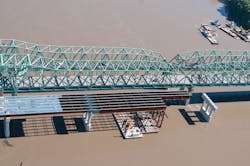325 is their 9-1-1
Earlier this year Ed Hassinger met up with a small group attempting to save the I-44 Bridge over the Gasconade River in Missouri. The closed span was draped over the famous Rte. 66, and the people that had Hassinger’s ear were willing to go to the ends of the Earth to get the bridge the treatment it deserved. The passports they were holding, however, would never get them in line to vote.
“There was a Save the Bridge event and people flew in from Germany, Sweden, and I said to them, ‘You didn’t come just for some other reason and just happened to be in the area?’ They said they got on a plane and came all the way from Europe,” Hassinger, chief engineer at the Missouri Department of Transportation (MoDOT), told Roads & Bridges. “I thought, wow, if I can only get this much interest for this problem in Missouri.”
There wasn’t enough of a wow factor with Missouri voters back in August 2014 when Amendment 7 was rejected by a healthy margin. The measure, which called for a three-quarter-cent increase in the state sales tax, would have generated $5.4 billion over a decade, funding 800 transportation projects across the state.
“I’m not going to say I was surprised that it was defeated,” said Hassinger. “I guess I was a little surprised that it was defeated pretty handily. I think Missourians were telling us it was too big and it was too comprehensive, and they are too conservative and want something that takes care of the existing system.”
Adding to the magnitude of the problem is the number of bridges (48) Missouri has crossing major rivers like the Mississippi. Those are over 1,000 ft long and cost anywhere from $50 million to $200 million to replace. About 100 bridges go on the structurally deficient list every year.
The schedule to convince the voters also was too tight. Faced with a handful of amendments, Missouri Gov. Jay Nixon decided to split the number and put some on the August ballot and some on the November ballot. Amendment 7 was in the first group, which gave MoDOT and its supporters little time to travel the state and cover exactly what was behind the sales-tax increase. For a little more money, Missouri would have been able to fund infrastructure projects on a grand scale. The list included light rail, transit, port development and aviation, along with road and bridge improvements.
“It was a general sales tax that could be used for all types of transportation, and even in rural Missouri where transit is not very popular they could see this going to help our Older Adults Transportation System, our OATS buses, so that was exciting,” Roberta Broeker, interim director of MoDOT, told Roads & Bridges. “We had a project list out there that we think would have been pretty effective if there would have been more time to let people know what they were really voting for.”
With Amendment 7 dead on the table Missourians may soon find out what the road and bridge issue is really about. MoDOT is currently operating on a $700 million budget, but by 2017 that number will fall off a cliff—to $325 million. The amount will be used to take care of a small sliver of the state’s 33,000+ miles of pavement and 10,000+ bridges. MoDOT’s current forecast shows the agency will be $40 million short in state revenues to match federal funds in 2017, and currently it takes $485-$500 million annually to maintain the system.
“We are trying to make the responsible decision to keep the roads that connect Missouri in good shape and that comes at the sacrifice of having to let some of these roads only get routine maintenance, which is not going to be a good thing in this state,” said Hassinger.
Safe, sound and smooth
It wasn’t long ago MoDOT had a good thing going. When the Smoother, Safer, Sooner campaign launched in 2005, just 40% of Missouri’s interstates were rated in good condition. This time voters allowed an amendment to live. Amendment 3 allowed for existing revenue that used to go to that state’s general fund to be moved over to cover some road and bridge projects. MoDOT decided to put it towards 5,500 miles of pavement.
“We took the heaviest travelled roads in Missouri and not only made them smooth, but did all the safety improvements that we thought would reduce road fatalities,” said Hassinger. “We put in rumble strips and guard cable, better signs and did whatever pavement work was needed.”
Most of the work, completed in 2007, consisted of simple overlays that had a seven-year lifespan, and now 89% of Missouri highways are in good condition, and 78% of the 28,000 miles of smaller, two-lane rural roads are still performing well.
MoDOT’s encore to Smoother, Safer, Sooner was the Safe & Sound Bridge Improvement Program, which was launched in 2008. The goal was to make a dent in the state’s structurally deficient bridge list behind a $685 million budget, with much of the funding coming from Grant Anticipation Revenue Vehicle (GARVEE) bonds. In 2009 KTU Constructors, a joint venture of Kiewit Western Co., Traylor Brothers Inc. and United Contractors Inc., was named the design-builder, and within five years 802 bridges, averaging just 150 ft long, no longer had the structurally deficient tag, and in 2013 79% of Missouri’s bridges were listed in good condition.
“That was huge,” said Broeker. “We replaced or repaired 800 of the worst bridges we had in the state, so we had the happy ability to look at our measures and say for that little period of time the number of bridges in bad condition actually improved.”
However, the two success stories actually helped set the theme of Amendment 7’s defeat. Many voters across the state see nothing but solid pavement and bridge decks, but pull back the curtain shielding current conditions and what is revealed are numbers setting the stage for a deep, dark nightmare that might not contain an intermission.
According to Hassinger, if funding continues to be a struggle over the next 10 years 75% of the 26,000 miles of what MoDOT has classified as secondary roads will be in poor condition and as many as 90 bridges could be closed.
“[The condition of the roads] is declining rapidly,” said Hassinger. “You are going to see huge reductions in the condition of those roads, and a majority of those roads are ones where we are not going to do any contract investment, so there won’t be anything more than what our maintenance folks can do with a dump truck and a shovel.”
Missouri’s bridge network is really the beast that lies within. The state has over 10,000 bridges, and according to Hassinger about 2,000 are in poor condition. Most of the spans on the Interstate Highway System were built in the 1950s and 1960s, and a good number were constructed as early as the 1930s. Adding to the magnitude is the number of bridges (48) Missouri has crossing major rivers like the Mississippi. Those are over 1,000 ft long and cost anywhere from $50 million to $200 million to replace. Hassinger said about 100 bridges go on the structurally deficient list every year, which means the positive effect of the Safe & Sound program has already worn off.
“Now that our funding is going down we are not replacing 100 a year, and so that 800-bridge benefit is quickly eroding to where we are just going to get back to a break-even point,” declared Hassinger. “It’s just a huge problem for us. Our bridge problem is not going away.”
Cutting, saving and hopeful
So how does Missouri break this negative cycle? MoDOT has done all it can. In 2011 the agency did a complete reorganization where the workforce was downsized by 20% and 130 buildings, including three district offices, were closed. MoDOT also sold 750 pieces of equipment.
The strategy moving forward is being called Missouri’s 325 System—as in $325 million—and the Missouri network has been divided into two groups. If the funding level does drop down to $325 million in 2017, all of it will be spent on 8,000 miles of what MoDOT considers primary routes. They mainly consist of interstates and roads that connect to major towns that have populations of 1,000 or more. The remaining 26,000 miles will only receive minor patches when they are necessary, and if a bridge has to be closed, and it is part of the 26,000, there will be no plans to reopen it. At press time there were six spans where traffic was banned, and three of them will remain that way until the funding situation turns around.
MoDOT also continues to engage in cost-cutting or financially responsible practices. The agency sets a price for its design-build projects and forces interested contractors to work within the budget.
Complete closures during construction are another option. The strategy was employed during the Safe & Sound program, where instead of closing half of a bridge at a time, traffic was diverted entirely. The move eliminates the cost of traffic management.
MoDOT also is doing more chip-sealing projects than ever before, and crews also are laying down what Hassinger called a “heavy micro” layer of asphalt, which is twice the material used for micro paving.
An annual innovations challenge for MoDOT employees has a history of generating money-saving ideas that are implemented out on the road, and the contest is expected to continue.
Recent actions from the state legislature also might raise the level of confidence. The state House of Representatives was working on a bill that called for a 1.5-cent increase in the state gas tax (3.5-cent increase for diesel). The proposal also called for the creation of a board that would consider making I-70 a toll road under a public-private partnership. The state Senate also was considering a gas-tax increase, but neither chamber could pass a bill prior to the May 15 recess.
While a 1.5- to 2-cent increase certainly would be welcomed, Broeker said the state needs more like a 4- to 6-cent hike at the pump.
“We need about $160 million a year in additional state revenues to fully match federal funds and be able to do systematic safety improvements,” she said. “By delaying until 2016 and then you don’t begin to collect that increment of additional gas tax until 2017 . . . I’m not sure you can get it in fast enough to solve the problem in ‘17.
“After the defeat of Amendment 7, I truly did not expect funding to be discussed in the legislative session this year because it was a resounding defeat. I was amazed that it got as far as it did and it had as much support as it did.
An annual innovations challenge for MoDOT employees has a history of generating money-saving ideas that are implemented out on the road, and the contest is expected to continue.
“I can’t afford not to be optimistic,” Broeker went on. “I can’t afford not to believe that we won’t come up with the solution and we will be able to avoid 325, but the time is getting very short.”
Support, however, is starting to stretch out across the state. When the state legislature announced the possibility of increasing the state gas tax, every major newspaper in Missouri supported such a move. That did not happen when Amendment 7 was monopolizing the headlines.
“I think our legislators get it, and I think our public is starting to get it,” said Hassinger. “This is just a long-term education process. People are going to get it.” R&B


